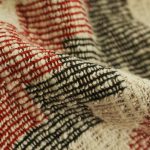When you're faced with the choice between microsuede and suede, it's essential to understand their distinct qualities. Microsuede, a synthetic option, offers durability and ease of maintenance, while traditional suede, made from animal hides, provides a luxurious texture but demands careful handling. Each fabric has its own set of advantages and drawbacks that could significantly impact your decision. So, how do you know which one truly fits your lifestyle and aesthetic needs? Let's explore the nuances that might sway your choice.
Table of Contents
Key Takeaways
- Microsuede is a synthetic fabric made from polyester, while suede is a natural leather derived from animal hides.
- Microsuede is more durable, stain-resistant, and easier to clean compared to traditional suede, which requires special care.
- Suede offers a luxurious texture and develops a beautiful patina over time, enhancing its aesthetic appeal.
- Microsuede has a smoother, more uniform texture, whereas suede features natural imperfections that add character.
Definition of Microsuede
Microsuede is a synthetic fabric made from polyester that mimics the soft texture and appearance of natural suede. This material is crafted using ultra-fine fibers, giving it a plush feel that's both durable and attractive. You'll notice that microsuede is lighter than traditional suede, making it a practical choice for various applications, from furniture upholstery to clothing.
One of the main advantages of microsuede is its resistance to stains and fading. Unlike natural suede, which can absorb liquids and become discolored, microsuede repels moisture, making it easier to clean and maintain. You can simply wipe it down with a damp cloth, and it usually looks as good as new.
Additionally, microsuede is often more affordable than genuine suede, giving you a cost-effective option without sacrificing style. It's also widely available in numerous colors and patterns, so you can easily find the perfect match for your decor or wardrobe.
With its soft feel and practicality, microsuede is an excellent choice for anyone looking to enjoy the look of suede without the high maintenance and cost.
Definition of Suede
Suede is a luxurious leather made from the underside of animal hides, offering a soft and velvety texture that's highly sought after in fashion and upholstery. It's typically derived from lamb, goat, or cow hides, giving it a unique appeal and durability. When you touch suede, you'll notice its plush feel, which adds a rich aesthetic to clothing, shoes, and furniture.
One of the key characteristics of suede is its ability to develop a beautiful patina over time, enhancing its charm. However, you need to take special care of it, as it's more susceptible to stains and water damage compared to other leathers. Regular brushing with a soft brush can help maintain its appearance, while special suede cleaners can address any stubborn stains.
Suede comes in various colors and finishes, allowing you to find the perfect match for your style. It's versatile, easily integrating into both casual and formal wardrobes. Whether you're considering a pair of suede boots or a stylish jacket, it's sure to elevate your look.
Key Differences Between Materials
When choosing between microsuede and suede, you'll notice key differences in texture and feel.
Each material also varies in terms of durability and maintenance, which can impact your decision.
Let's explore how these factors play a role in your selection.
Texture and Feel
The texture and feel of microsuede often mimic that of traditional suede but offer a smoother, more uniform surface that many find appealing. When you run your fingers across microsuede, you'll notice its soft, velvety touch, which can feel luxurious against your skin. This pleasing texture makes it a popular choice for upholstery, clothing, and accessories.
On the other hand, traditional suede has a more varied texture, with natural imperfections that add character. You might appreciate the uniqueness of suede, as it feels more organic and rich. However, this variation can also mean that the texture isn't as consistent as microsuede.
In terms of breathability, both materials have their strengths, but traditional suede tends to allow for slightly more airflow, making it feel cooler against your body in warm weather. You might find that microsuede, while soft, can feel warmer, especially when used in heavier applications like jackets or cushions.
Ultimately, your choice between microsuede and suede will depend on your preference for texture and feel, along with how you plan to use the material.
Durability and Maintenance
Microsuede generally outlasts traditional suede in terms of durability, making it a more practical choice for everyday use. This synthetic material is designed to resist stains and fading, which means it can handle the wear and tear of daily life without losing its appeal. Since it's made from polyester fibers, microsuede can also withstand moisture better than its natural counterpart.
Traditional suede, while luxurious, requires more careful handling and maintenance. It's sensitive to water and can easily absorb stains, making it less suitable for high-traffic areas or homes with kids and pets. If you choose suede, you'll need to invest in protective sprays and regularly brush it to maintain its texture.
When it comes to cleaning, microsuede is a breeze. You can usually wipe it down with a damp cloth or use a mild soap solution for tougher stains. Suede, on the other hand, often requires specialized cleaners and professional treatments, which can be time-consuming and costly. Ultimately, if you want a fabric that looks great without the constant upkeep, microsuede is your best bet.
Pros and Cons of Microsuede
You'll find that microsuede offers a mix of advantages and drawbacks worth considering before making a decision. One of the most significant benefits is its durability. Unlike genuine suede, microsuede is resistant to stains and is easy to clean, making it ideal for homes with pets or kids. Its soft texture mimics the feel of real suede, providing comfort and a stylish appearance. Additionally, it's often more affordable than traditional suede, which can be a huge plus for your budget.
However, there are some downsides to keep in mind. While microsuede is generally durable, it can be susceptible to wear and tear over time, especially in high-traffic areas. It's also less breathable than natural suede, which might be a concern if you're using it for clothing or upholstery in warmer climates. Furthermore, some people find that the synthetic material doesn't have the same luxurious appeal as genuine suede, which might affect your overall aesthetic.
Pros and Cons of Suede
When comparing microsuede to genuine suede, it's important to explore the unique advantages and disadvantages that real suede offers. One of the main pros of suede is its luxurious feel and rich texture, which can elevate the aesthetic of any item, whether it's a pair of shoes or a handbag.
Suede is also known for its durability; with proper care, it can last for years. Additionally, suede has a natural breathability that makes it comfortable to wear in various climates.
However, there are downsides to consider. Suede can be prone to staining and water damage, which means it requires special cleaning and maintenance. Unlike microsuede, which is more resistant to spills and dirt, real suede can absorb liquids and may be difficult to clean.
You'll also find that suede is generally more expensive than its synthetic counterpart, which mightn't fit every budget.
Best Uses for Each Fabric
When you're choosing between microsuede and suede, it's important to consider where you plan to use each fabric.
Microsuede works great for items that need durability and easy maintenance, while suede adds a touch of luxury to clothing and accessories.
Let's explore the best applications for both fabrics to help you make an informed choice.
Ideal Applications for Microsuede
Microsuede is perfect for a variety of applications, including upholstery, apparel, and accessories, thanks to its durability and soft texture.
When you're looking to furnish your home, microsuede makes an excellent choice for sofas and chairs. Its stain resistance and easy maintenance mean you can enjoy your furniture without worrying about spills or wear.
In apparel, microsuede is a fantastic option for jackets, skirts, and vests. It offers a stylish look with the feel of real suede, but it's lighter and often more affordable. You can wear it comfortably throughout the day, and it holds up well to regular use.
Accessories like handbags, shoes, and throw pillows also benefit from microsuede's versatility. You'll find it in trendy bags that combine fashion with functionality, as well as in cozy throw pillows that add a touch of luxury to your living space.
Additionally, if you have pets, microsuede is a smart choice for pet beds. Its durability ensures that it withstands wear and tear while remaining soft and inviting for your furry friends.
Preferred Uses for Suede
Suede shines in applications where luxury and sophistication are key, making it ideal for high-end fashion items, footwear, and elegant home decor.
When you think of chic jackets, stylish boots, or sophisticated handbags, suede often comes to mind. Its soft texture and rich appearance elevate any outfit, drawing attention and admiration.
In home decor, suede can transform your space. Consider using it for throw pillows, upholstered furniture, or curtains to add warmth and elegance to your living area. Its ability to complement various color palettes makes it a versatile choice for interior design.
When it comes to accessories, suede belts and wallets aren't only functional but also add a touch of refinement to your everyday look.
Keep in mind that while suede is luxurious, it requires proper care to maintain its appearance. Regularly brushing and treating it with appropriate protective sprays can keep it looking its best.
Frequently Asked Questions
Can Microsuede Be Made From Recycled Materials?
Yes, microsuede can be made from recycled materials. Many manufacturers use recycled polyester derived from plastic bottles, creating a sustainable option. So, when you choose microsuede, you're often supporting eco-friendly practices and reducing waste.
How Does the Cost of Microsuede Compare to Genuine Suede?
Microsuede typically costs less than genuine suede, making it a more affordable option for many. You'll find that while both materials have their benefits, microsuede offers a budget-friendly choice without sacrificing style or comfort.
Is Microsuede Hypoallergenic or Safe for Sensitive Skin?
Yes, microsuede's generally hypoallergenic and safe for sensitive skin. It's synthetic, so it doesn't contain natural allergens found in some materials. You'll likely find it comfortable and gentle, making it a great choice for your needs.
What Is the Environmental Impact of Producing Microsuede?
When you consider the environmental impact of producing microsuede, you'll find it typically requires less water and energy than traditional fabrics. However, its production can still involve chemicals that may harm ecosystems if not managed properly.
Can Suede Be Waterproofed or Treated for Outdoor Use?
Yes, you can waterproof suede by applying a specialized treatment or spray designed for leather. It's important to regularly reapply the treatment to maintain its effectiveness, especially if you're using it outdoors.
- Tetron Fabric for Marine Applications: Durability and Use Cases - June 18, 2025
- Tetron Fabric for Outdoor Furniture: Weather Resistance and Care - June 18, 2025
- Tetron Fabric for Wall Coverings: Style and Application Tips - June 18, 2025







